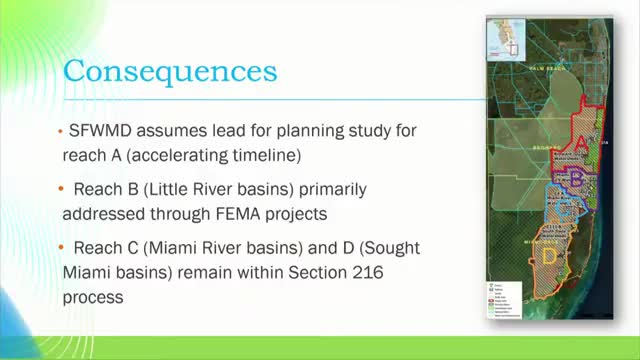Broward County unveils ambitious flood resilience strategy
September 14, 2024 | Broward County, Florida
This article was created by AI summarizing key points discussed. AI makes mistakes, so for full details and context, please refer to the video of the full meeting. Please report any errors so we can fix them. Report an error »

In a recent government meeting, officials discussed critical updates regarding flood risk management and resilience planning for Broward County. The meeting highlighted the ongoing efforts to address the challenges posed by rising sea levels and increased flooding risks, particularly in light of climate change.
Key discussions centered around the C-9 canal, which serves as a border between Dade and Broward counties. While the canal's management is recognized as a shared interest, it was noted that it is not currently included in the immediate resilience plans. However, water management strategies are being modeled to address the entire basin, with expectations that future studies will incorporate these considerations.
Dr. Rata provided an update on the county's resilience plan, emphasizing the importance of adaptation strategies to mitigate future flood risks. The plan includes a variety of measures such as green infrastructure, groundwater storage, and improvements to canal operations. The officials presented maps illustrating different geographic regions and their specific water management needs, highlighting the varying levels of flood risk across the county.
The meeting also addressed the projected impacts of flooding under various scenarios, including a 100-year storm surge combined with sea level rise. It was acknowledged that while adaptation strategies could significantly reduce flood risks, some flooding would still occur during extreme weather events. The officials stressed that the goal is to minimize damages and preserve property values and economic activities.
A tiered investment approach was proposed, with Tier 1 focusing on immediate improvements such as green infrastructure and seawall upgrades, while Tier 2 would involve more significant enhancements, including higher seawalls and additional pumping capacity. The timeline for implementing these projects is set with a target for Tier 1 improvements to be completed by 2050.
Economic analyses presented during the meeting indicated that implementing these adaptation strategies could lead to substantial reductions in residential damages and property value losses. Without any adaptation measures, property values in Broward County could decline significantly due to flooding risks. However, with the proposed Tier 1 and Tier 2 improvements, the county could preserve property values and reduce overall exposure to flooding.
The meeting concluded with a call for continued collaboration among stakeholders to refine and implement these strategies effectively, ensuring that Broward County is better prepared for the challenges posed by climate change and rising sea levels.
Key discussions centered around the C-9 canal, which serves as a border between Dade and Broward counties. While the canal's management is recognized as a shared interest, it was noted that it is not currently included in the immediate resilience plans. However, water management strategies are being modeled to address the entire basin, with expectations that future studies will incorporate these considerations.
Dr. Rata provided an update on the county's resilience plan, emphasizing the importance of adaptation strategies to mitigate future flood risks. The plan includes a variety of measures such as green infrastructure, groundwater storage, and improvements to canal operations. The officials presented maps illustrating different geographic regions and their specific water management needs, highlighting the varying levels of flood risk across the county.
The meeting also addressed the projected impacts of flooding under various scenarios, including a 100-year storm surge combined with sea level rise. It was acknowledged that while adaptation strategies could significantly reduce flood risks, some flooding would still occur during extreme weather events. The officials stressed that the goal is to minimize damages and preserve property values and economic activities.
A tiered investment approach was proposed, with Tier 1 focusing on immediate improvements such as green infrastructure and seawall upgrades, while Tier 2 would involve more significant enhancements, including higher seawalls and additional pumping capacity. The timeline for implementing these projects is set with a target for Tier 1 improvements to be completed by 2050.
Economic analyses presented during the meeting indicated that implementing these adaptation strategies could lead to substantial reductions in residential damages and property value losses. Without any adaptation measures, property values in Broward County could decline significantly due to flooding risks. However, with the proposed Tier 1 and Tier 2 improvements, the county could preserve property values and reduce overall exposure to flooding.
The meeting concluded with a call for continued collaboration among stakeholders to refine and implement these strategies effectively, ensuring that Broward County is better prepared for the challenges posed by climate change and rising sea levels.
View full meeting
This article is based on a recent meeting—watch the full video and explore the complete transcript for deeper insights into the discussion.
View full meeting